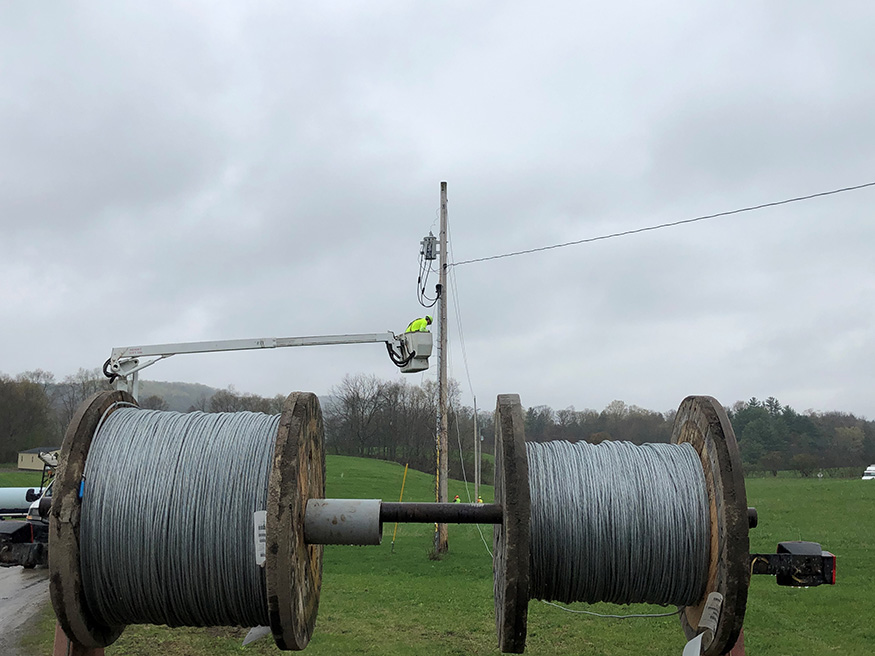Co-op Members
4,408
Total Miles of Fiber
850
Project Timeline
3 years
Centrally located in the rolling hills of New York, Otsego Electric Cooperative (OEC) knew members in its service territory were in desperate need of reliable, high-speed internet.
Originally published: February, 2023
The only local options for internet connectivity were DSL and satellite. Those with DSL were struggling with interference and lagging connections. Those with satellite were facing outrageous monthly bills, spending as much as $600 per month for the data they required.
The lack of internet access in OEC’s service territory was directly affecting the local economy. As a hot spot for tourism with Airbnb rentals and campgrounds throughout the region, high-speed connectivity was and is an expectation of the visitors who choose Central New York for vacationing or working remotely.
“We consider broadband an important part of economic development, but it’s also very personal. It’s important for social development, educational development, and medical and mental health connections,” OEC CEO Tim Johnson said. “It makes it possible for members to have access to telemedicine or educational pursuits here in our territory, rather than moving to more congested areas, like New York City.”
Johnson and his team at OEC began exploring options and partners to help them meet this critical need when he came on board in mid-2016. In the fall of 2016, Johnson met Conexon Partner Jonathan Chambers at a cooperatives’ regional meeting and the project quickly began to take shape, starting with essential funding.

"That decision had a direct impact on our communities’ ability to respond to the pandemic quickly and minimize the negative effects to follow."

The rollout of the “New York Broadband Program” made $500 million available through grants to internet providers in a reverse auction process. With Conexon’s guidance, the cooperative submitted a successful proposal. OEC won an initial $4 million grant in the first round of awards and another $10 million in the second round. That $14 million helped make OEC’s fiber subsidiary, OEConnect, a reality.
With grant money in hand, the clock was ticking. OEC made the decision to begin “make ready” work with its own electric crew members. “Although we are a small cooperative,” Johnson said “OEC’s crews are outstanding and did a fantastic job.” The strategy proved to be successful and OEC completed the first phase of its fiber project on time by 2019 and well under budget.
Upon receiving the second grant, Johnson’s team realized $14 million in grant funding would not be enough to build out the network to reach all of its members. With the full support of the OEC Board of Directors and Conexon’s assistance, including Jon Chambers’ advice, the cooperative quickly committed the remaining funds needed to cover the $23 million total network cost.
Like many other providers, OEConnect experienced a surge in demand from the COVID-19 pandemic – just as the network was lighting up. Its phones rang constantly as members suddenly found themselves at home, needing to work or learn remotely. The desire for fast, reliable internet service became a necessity for daily life practically overnight.
Because the waiting list for fiber service grew daily in early pandemic days, the cooperative made an intentional decision to connect healthcare professionals first. The co-op recognized that those on the front lines needed immediate access to new information as it was released. Doctors, nurses, and respiratory technicians were moved to the front of the line. They were quickly followed by psychiatrists, counselors, and telemedicine professionals.
“That decision had a direct impact on our communities’ ability to respond to the pandemic quickly and minimize the negative effects to follow,” Johnson explained.
Teachers, students, and teleworkers were prioritized next, which meant that members and their families could work and learn remotely with ease, connected to state-of-the-art gigabit service. In 2020, OEConnect welcomed more than 2,000 new customers.
Now in the project’s fifth year, OEConnect is serving 3,400 subscribers, many of whom are non-members, across 850 miles of line.

“We were not expecting to reach 3,000 customers until Year 8 of business. That milestone occurred in Year 3. We beat our goal by five years,” Johnson said proudly.
Johnson credits the broad expertise of the Conexon team, all of whom have worked alongside OEConnect since the project’s inception, with moving the OEC network build along quickly and smoothly. His advice to other cooperatives exploring fiber broadband is simple.
“Do your homework through feasibility studies and talk to a variety of vendors to truly understand the cost of rural builds,” Johnson said. “It’s smart to estimate conservative take rates, but there is the possibility that those numbers will be exceeded. It’s a win-win for everyone if broadband can be managed properly. That’s what we’re seeing thanks to our partnership with Conexon,” Johnson said.
As for what’s next with OEConnect? Johnson said the fiber subsidiary is planning a 100-mile off system fiber build that will pass more than 500 locations across 19 townships. “We’ve built to 100 percent of our members and now we’re starting this 100-mile off-system pass thanks to RDOF funding,” Johnson said. “Getting those homes and businesses hooked up as soon as possible is the number one priority right now as people are clamoring for us to get there.”